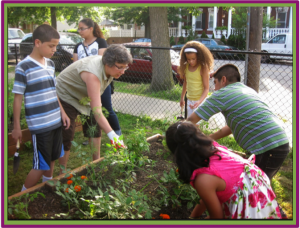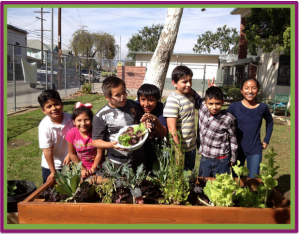The grassroots demand for garden-based learning and food literacy in schools is nothing new to the narrative of American education and activism. School gardens and activism surged from 1900 to 1930 in conjunction with Progressive Era education reforms.4 By 1918 every state in America had at least one school garden. In World War II Victory Gardens gained popularity, and in 1960 gained some attention in counter-culture environmental education movements. Progressive education research since the 1990s has reinvigorated the push for garden-based learning due to demand for experiential learning and environmental education options for students.5

5. City Green holds an educational workshop at a public library in Paterson, NJ.
This enthusism for garden-based learning time and time again shows the grassroots find some power and importance in the idea of educating students about the environment, what they eat, and finding a way to make learning integrative and interactive. This history of the greater demand for gardens shows how gardens and food literacy movements have been organized before, but have not always sustained and puts the urban grassroots garden-based learning and food literacy movements into a context of both success and struggle. There are structures and formulas for activists to implement successful garden and food programs for students in their communities.6
Yet grassroots organizations approach garden-based learning and food activism from diverse angles (from policy advocacy, to creating curriculum and after school programs) and for diverse reasons (including: obesity, nutrition, outdoor-play/recreation, environmental education, and whole-child learning). Most grassroots (and even formerly grassroots) garden-based learning and food literacy organizations trace their roots to motivated teachers, but these teachers often come together with parents, school board members, school administrators, community partners (such as garden experts and support staff) to implement the program or idea.
Though the message and mission varies between organizations, the overarching theme within the urban garden-based learning and food literacy grassroots movement is to use gardens and food literacy programs with students to fight for environmental justice and food justice by improving all students’ access to: green spaces, fresh and healthy food, and dynamic, integrated hands on learning.

6. Students work in the edible schoolyard of one the schools Berkley GC Alliance is trying to save.
This progressive, ambitious, and multi-pronged mission fights to make a dent in a heavily inequitable and industrialized American food system as well as against a highly standardized and confined American education system. And therefore, it does not come without challenges. These grassroots garden and food programs have been criticized as merely leftist, resource-sucking add-ons to an already full curriculum.7
Another challenge has been transitioning from merely providing garden and kitchen infrastructure to putting this infrastructure to work to deliver the promised and expected integrated learning.8
Though many would argue that the multitude of issues that garden-based learning and food literacy programming can help solve make it worth the resource intensity, that doesn’t change the fact that many communities and school systems do not have the expendable resources to start or maintain gardens, thereby scaling the movement.9

7. Students from L.A. Sprouts show off their bounty
Despite these challenges, grassroots urban garden and food education movements have made impacts on local communities. Luckily, researchers studied the pilot of the L.A. Sprouts grassroots after school gardening and food literacy program and found positive results.10 The study found that students who attended the program increased their preference for vegetables and preferred locally grown vegetables to those commercially grown and available at the grocery store. Though there is little data on the growth or success of urban garden and food programs (most grassroots efforts do not have the funds or connections for a study like L.A. Sprouts) with national attention through First Lady Michelle Obama’s healthy students and White House garden intiatives, and several generalized (not urban or grassroots) studies on the benefits of garden-based learning and food literacy one can imagine that the movement is gaining steam.11
